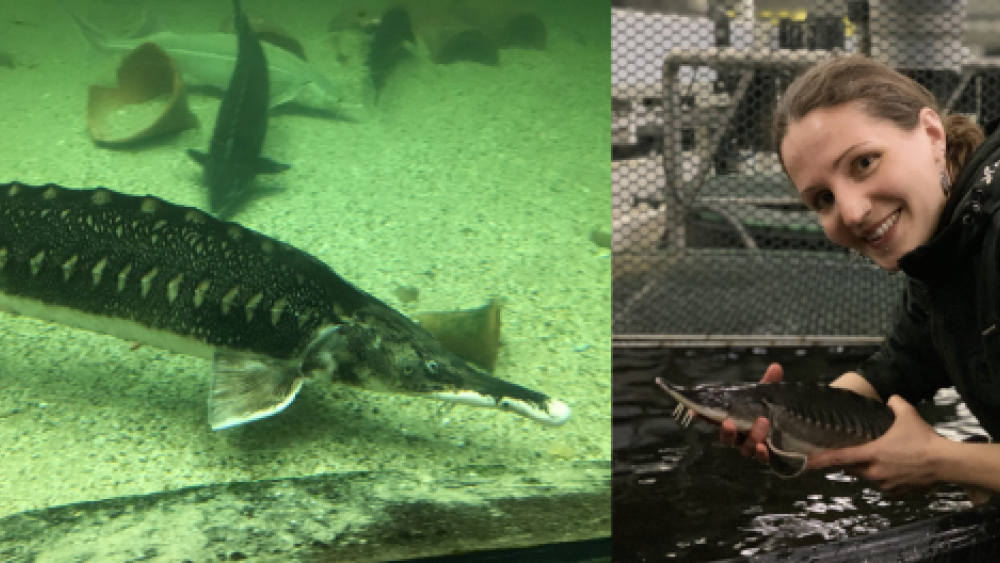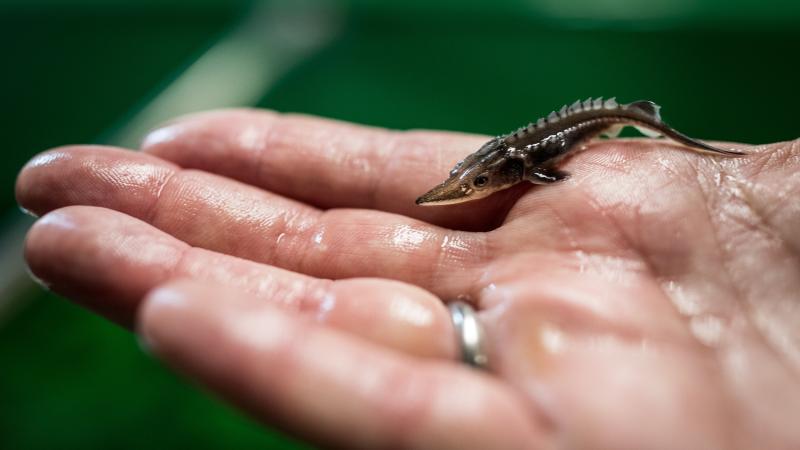
The starry sturgeon (Acipenser stellatus) is a typical Danube sturgeon and migrates to the Black Sea (left picture). Christin Höhne measured and weighed this Atlantic sturgeon (Acipenser oxyrinchus) to control its growth and adjust the amount of food (right picture). | Photos: Christin Höhne and IGB
What is so fascinating about the immune system of sturgeons?
Christin Höhne: Knowledge of the immune system of sturgeon species such as the Baltic sturgeon or the sterlet is important for research and practice: both evolutionary research and caviar- and meat-producing aquaculture benefit from the results, as do the protection of wild sturgeons and their re‐introduction through conservation measures. Owing to their phylogenetic age, sturgeons occupy a special place in the phylogenetic tree between sharks and bony fish such as carp and zebrafish. As such, they are a very interesting species for research into the evolution of the immune system. The exciting thing is that they duplicated their genome independently of real bony fish, which of course also had an impact on the fate of immune genes.
How do you go about studying an immune system?
We investigated the expression of immune genes, of which both gene copies have been preserved after genome duplication, in key player positions in order to be able to draw conclusions about the function of the genes. One of the findings was that some gene functions appear to be distributed across both copies, something we call sub-functionalisation in evolutionary research, in spite of simultaneous tissue specialisation, which I’ll say more about in a moment. This raises further questions about the signalling pathways of the immune system – information that is important for the development of specific vaccines, for example.
What do you hope to achieve with your work?
I want to contribute to a better understanding of the sturgeon’s immune system. I very much hope that, in the future, we will be able to react more effectively to diseases in breeding facilities, possibly even preventing disease outbreaks by vaccinating sturgeons at the right age. This is already the case in better-researched sectors of aquaculture, as the example of salmon shows. This is of great importance not only for commercial sturgeon aquaculture, but especially for our conservation and re-introduction programmes, which are crucial to sturgeons around the world.
In your overview article, you look at innate and adaptive immune systems. Which system held more surprises?
It must first be said that signalling pathways and components of innate and adaptive immune systems are strongly intertwined – not only in the sturgeon – making it virtually impossible to strictly separate the two systems. But if I look at it from a traditional perspective, the innate immune system surprised me most. For example, sturgeons and paddlefish have special lymphoid tissue associated with the brain and heart, where immune cells are produced and immune reactions occur. No other animals are known to have immune tissue in both the brain and the heart. In addition, their neutrophils, a subtype of white blood cells, lack the enzyme myeloperoxidase which is important for the intracellular digestion of pathogens, for example. Sturgeon neutrophils contain the enzyme phosphatase instead, a characteristic they share with birds. Receptors on the cell surface are responsible for recognising pathogens. Some of these receptors have so far only been found in mammals; they are missing in birds, reptiles and amphibians. Some receptors, however, including the so-called Toll-like receptor 6, have also been discovered in sturgeons and sharks in recent years. Multiple gene copies of some receptors have been found in sturgeons; This could possibly mean that they could also bind other ligands, and thus recognise different pathogens, than the same receptors do in humans, for example.
You identified a lot of unknowns in your article: Which aspect will you tackle next?
The adaptive immune system of sturgeons has been little studied to date. However, current knowledge suggests that it shares basic components with mammals. Some further studies are needed to understand the functional relationships and signalling pathways of the sturgeon immune system. A task that remains exciting, owing to genome duplication. The next thing I want to investigate is how the immune system of sturgeons changes during their development from larvae to juvenile sturgeon. From this, I hope to be able to derive a recommendation as to the optimal time window for possible vaccinations. I also want to identify marker genes that can be used to determine disease resistance. When selecting suitable breeding fish, these marker genes could help ensure that vigorous sturgeon offspring are produced in the future.
Read the article open access in Reviews in Aquaculture >
Work on the immune system of sturgeons is being conducted as part of work package 4 of the STURGEoNOMICS project.




